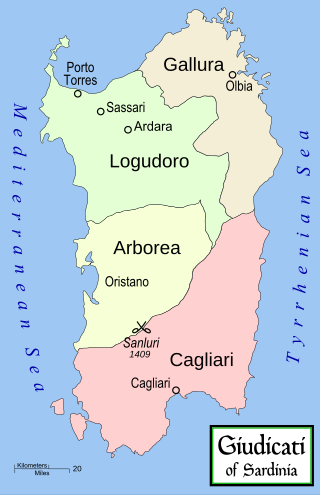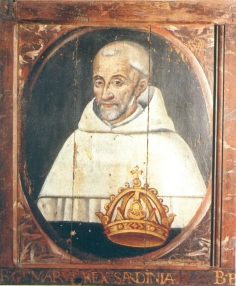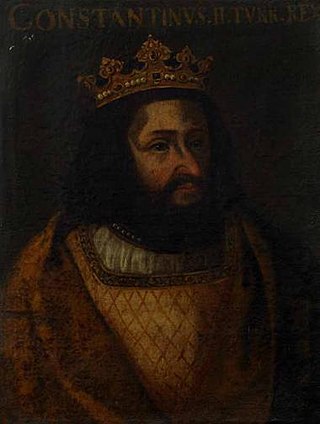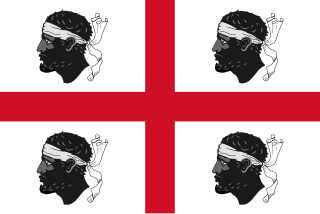Sources
- Caravale, Mario (ed). Dizionario Biografico degli Italiani.
Nuvolone Alberici (alternatively Nuvelonus, Nubelo, or Nebolonus) was a diplomat and statesman of the early Republic of Genoa during some of its formative years. He was a brother of Ottobuono Alberici.
He was first appointed a console dei placiti and socio within a società, a trading society, commercing with Sicily in 1158. In 1160, he was reelected with his brother and, in 1162, he was elected console del Comune, the highest political post in the republic. On 9 June, he was at the court of the Emperor Frederick I to secure recognition of the Genoese commune. He was reelected consul in 1168 and 1178.
In 1164, he went with the genero (general) Anglerio to Algeria to establish a società in Béjaïa. In 1168, he travelled to Sardinia to mediate the war between the filogenovesi and filopisani, the supporters of Genoa and Pisa, respectively. He forced a treaty on the warring giudicati of Arborea, Logudoro, and Cagliari and obtained a promise from Barison II of Logudoro to defend the rights of Genoa in Arborea, then under the control of another Barison II, who had defaulted on his tribute to the Genoese in return for the royal coronation they had obtained for him in 1164.
In 1169, Nuvolone and Baldizone Usodimare resolved a territorial controversy in Versilia with ambassadors from Pisa and Lucca. In 1171, he was at the latter city to negotiate a treaty forming a common army.
Around 1170, he received Byzantine ambassadors from Manuel I at Terracina with three ships. Manuel was seeking to ally with Pisa and Genoa against Venice. In 1179, Nuvolone accompanied the archbishop of Genoa, Ugone della Volta, to the First Lateran Council in Rome. Nuvolone was reelected consul in 1181, 1184, and 1192, the last time despite the arrival of Manegoldo del Tettoccio da Brescia, who had made himself the first podestà , in 1190.

The Republic of Genoa was a medieval and early modern maritime republic from the 11th century to 1797 in Liguria on the northwestern Italian coast. During the Late Middle Ages, it was a major commercial power in both the Mediterranean Sea and the Black Sea. Between the 16th and 17th centuries, it was one of the major financial centers in Europe.

The Judicate of Arborea or the Kingdom of Arborea was one of the four independent judicates into which the island of Sardinia was divided in the Middle Ages. It occupied the central-west portion of the island, wedged between Logudoro to the north and east, Cagliari to the south and east, and the Mediterranean Sea to the west. To the northeast and beyond Logudoro was Gallura, with which Arborea had far less interaction. Arborea outlasted her neighbours, surviving well into the 15th century. At its greatest territorial extent it occupied the entire island except the cities of Alghero and Cagliari. The earliest known judicial seat was Tharros, though Oristano served as capital for most of its existence.

The maritime republics, also called merchant republics, were Italian thalassocratic port cities which, starting from the Middle Ages, enjoyed political autonomy and economic prosperity brought about by their maritime activities. The term, coined during the 19th century, generally refers to four Italian cities, whose coats of arms have been shown since 1947 on the flags of the Italian Navy and the Italian Merchant Navy: Amalfi, Genoa, Pisa, and Venice. In addition to the four best known cities, Ancona, Gaeta, Noli, and, in Dalmatia, Ragusa, are also considered maritime republics; in certain historical periods, they had no secondary importance compared to some of the better known cities.

Barison II or Barisone II was the "Judge" of Arborea, one of the four Judicates of Sardinia, from 1146 to 1186. He was the son of Comita II and Elena de Orrubu. His reign was groundbreaking in Sardinian history. It saw the birth of Catalan influence, the escalation of the Genoese-Pisan conflict, and the first royal investiture over the entire island when Barisone was briefly recognised as King of Sardinia by the Holy Roman Emperor from 1164 to 1165.

Barison II or Barisone II was the giudice of the Judicate of Logudoro from 1153 to 1186. He was the son and successor of Gonario II, who abdicated the throne and retired to the monastery of Clairvaux to live out his days.

Comita III was the giudice of Logudoro, with its capital at Torres, from 1198 until 1218. He was the youngest of four sons of Barisone II of Torres and Preziosa de Orrubu. He ruled at a time when the great families, usually foreign, were superseding the giudici in power and influence on Sardinia.

Comita II or III was the giudice (judge) of the Judicate of Arborea from 1131 until his death. He was the son of Constantine I of Arborea, the first ruler of Arborea of the Lacon dynasty. He married Elena de Orrubu, mother of Barison II of Arborea. The dating and chronology of his reign are obscure.

William I, royal name Salusio IV, was the judike of Cagliari, meaning "King", from 1188 to his death. His descendants and those of his immediate competitors intermarried to form the backbone of the Italian Aristocracy, and ultimately their descendants in the Medici clan are precursors to, and definers of later royalty and claims thereto.

Gonario II was the giudice of the Sardinian kingdom of Logudoro from the death of his father in 1128 until his own abdication in 1154. He was a son of Constantine I and Marcusa de Gunale. He was born between 1113 and 1114 according to later sources and the Camaldolese church of S. Trinità di Saccargia was founded in his name by his parents on 16 December 1112, though it was not consecrated until 5 October 1116.

Constantine II, called de Martis, was the giudice of Logudoro. He succeeded to the giudicato sometime between 1181 and 1191. He was the son of Barisone II and Preziosa de Orrubu. His father associated him with the government in 1170 and abdicated the throne to him around 1186. His reign was generally characterised by contemporary chroniclers as "tyrannical."

The Judicate of Gallura was one of four Sardinian judicates in the Middle Ages. These were independent states whose rulers bore the title iudex, judge. Gallura, a name which comes from gallus, meaning rooster (cock), was subdivided into ten curatoriae governed by curatores under the judge. In the 13th century, the arms of Gallura contained a rooster.

Marianus II was the Judge of Logudoro from 1218 until his death. He was an ally of the Republic of Genoa and enemy of Pisa.

Peter I, of the Serra family, was the eldest son and successor of Barisone II of Arborea, reigning from 1186 to his death. His mother was Barisone's first wife, Pellegrina de Lacon. He was crowned King of Sardinia, the title his father had used, with the support of a majority of the Arborean nobility.
Ubaldo I Visconti was the de jure overlord of the Giudicato of Cagliari from 1217. He was a member of the Visconti family of Pisa, controlling Cagliari on behalf of his brother, who was judge jure uxoris from 1218.

Torchitorio III, born Peter, was the Judge of Cagliari from October 1163 to his deposition and arrest in 1188, after which he was never heard of again.
William of Capraia was the regent for Marianus II of Arborea from 1241 until his death, being entitled "Judge" from 1250 on.

The Kingdom of Sardinia, also referred to as the Kingdom ofSardinia-Piedmont or Piedmont-Sardinia as a composite state during the Savoyard period, was a country in Southern Europe from the late 13th until the mid 19th century.
Oberto D'Oria was an Italian politician and admiral of the Republic of Genoa, ruling the republic as Capitano del popolo.

The Aragonese conquest of Sardinia took place between 1323 and 1326. The island of Sardinia was at the time subject to the influence of the Republic of Pisa, the Pisan della Gherardesca family, Genoa and of the Genoese families of Doria and the Malaspina; the only native political entity survived was the Judicate of Arborea, allied with the Crown of Aragon. The financial difficulties due to the wars in Sicily, the conflict with the Crown of Castile in the land of Murcia and Alicante (1296-1304) and the failed attempt to conquer Almeria (1309) explain the delay of James II of Aragon in bringing the conquest of Sardinia, enfeoffed to him by Pope Boniface VIII in 1297.

The Kingdom of Sardinia was a feudal state in Southern Europe created in the early 14 century and a possession of the Crown of Aragon first and then of the Spanish Empire until 1708, then of the Habsburgs until 1717, and then of the Spanish Empire again until 1720.